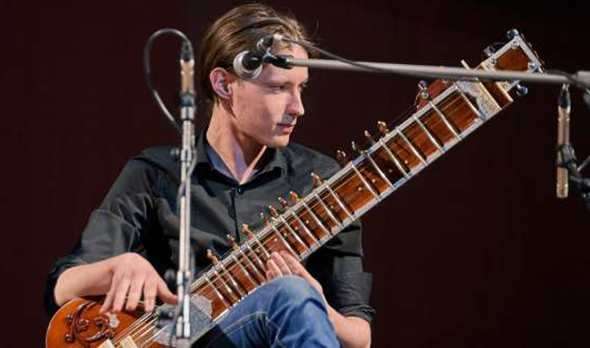
History of the sitar
A musical plucked instrument with seven main strings sitaroriginates in India. The name is based on the Turkic words “se” and “tar”, which literally means seven strings. There are several analogues of this instrument, one of which has the name “setor”, but it has three strings.

Who and when invented the sitar
The thirteenth century musician Amir Khusro is directly related to the origin of this unique instrument. The first sitar was relatively small and very similar to the Tajik setor. But over time, the Indian instrument increased in size, thanks to the addition of a gourd resonator, which gave a deep and clear sound. At the same time, the deck was decorated with rosewood, ivory was added. The neck and body of the sitar were dotted with hand-painted and various patterns that had their own spirit and designation. Before the sitar, the main instrument in India was the ancient plucked device, the image of which has been preserved on bas-reliefs dating back to the 3rd century AD.

How the sitar works
Orchestral sound is achieved with the help of special strings, which have the specific name “bourdon strings”. In some examples, the instrument has up to 13 additional strings, while the body of the sitar consists of seven. Also, the sitar is equipped with two rows of strings, two of the main strings are intended for rhythmic accompaniment. The five strings are for playing melodies.
If in the Tajik setor the resonator is made of wood, then here it is made from a special kind of pumpkin. The first resonator is attached to the top deck, and the second – small in size – to the fingerboard. All this is done to enhance the sound of the bass strings, so that the sound is more “thick” and expressive.
There are several strings in the sitar that the musician does not play at all. They are called tarab, or resonating. These strings, when played on the fundamentals, make sounds on their own, forming a special sound, for which the sitar has received the name of a unique instrument.
Even the fretboard is made using a special type of tun wood, and the decoration and carving are done by hand. Also, it is worth noting that the strings lie on two flat stands made of deer bones. The peculiarity of this design involves the constant undermining of these flat bases so that the string gives out a special, vibrating sound.
Small arched frets are made of materials such as brass, silver, to make it easier to give the shape with which the sound will be more pleasant to the ear.

Sitar Basics
The musician has a special device for playing the original Indian instrument. Its name is mizrab, outwardly it looks very much like a claw. The mizrab is put on the index finger, an up and down movement is made, thus retrieved unusual sound of the sitar. Sometimes the technique of combining the movement of the mizrab is used. By touching the “chikari” strings during the game, the sitar player makes the musical direction more rhythmic and definite.
Sitar players – history
The undisputed sitar virtuoso is Ravi Shankar. He began to promote Indian instrumental music to the masses, namely to the west. Ravi’s daughter, Anushka Shankar, became a follower. Absolute ear for music and the ability to handle such a complex instrument as the sitar is the merit of not only the father, but also the girl herself – such love for the national instrument cannot disappear without a trace. Even now, the great sita player Anushka gathers a huge number of connoisseurs of real live music and puts on wonderful concerts.





